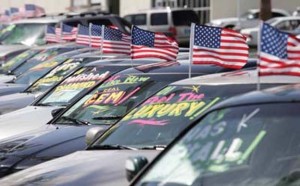Led by the U.S. and China, global auto sales have been on a tear in recent years, reaching all-time record numbers despite the poor performance in markets like Europe and Latin America. But a new study warns that demand is going to soften – and soon.
Worldwide, sales will continue to increase, according to the annual automotive outlook produced by Detroit-based turnaround specialist AlixPartners. But the rate of growth will slip to an annual 2.6% for the next seven years, down from 3.1% between 2007 and 2014.
The U.S. and China will likely see the sharpest slowdowns, the study warns, emphasizing that “cyclicality has not been permanently repealed.”
In the U.S. market, it’s not just the new car market that is likely to hit its peak in 2016 – at slightly more than the 17.1 million vehicles forecast by AlixPartners this year. The study cautions that there may be a “used-car bubble forming which would drive down prices for new and used vehicles, as well.”
As for China, it’s today the world’s largest automotive market, accounting for a full 28% of global new vehicle sales. The study forecasts growth continuing through 2018 at an annual rate of 5.2%. That would be a great number in the U.S. or Europe, but not in light of the fact that the Chinese market grew at an average pace of 16.6% between 2005 and 2016 – in some years approaching triple-digit numbers.
(Not everyone thinks US auto sales have peaked. For a counterpoint, Click Here.)
The study also looks at global earnings, and underscores the fact that the lion’s share of profits now come from Asia and the subcontinent. Last year, it notes, “Chinese and Indian automakers cumulatively earned 35% more net income, $11 billion, than U.S. automakers,” who generated $8 billion.
But China and India have nothing on Japan where automakers collectively rolled up net earnings of $42 billion in 2014, at least in part due to the weak yen. Whether they can maintain that pace as exchange rates stabilize is another question.
Despite the weakness of the overall market, European automakers also handily out-performed Detroit – as well as China and India – generating $31 billion in net income. But the vast bulk of that, notes the AlixPartners study, came from luxury brands.
Intriguingly, its automotive suppliers, rather than automakers, who are generating the big earnings in North America, the study points out. One reason has been the sharp drop in prices for commodities like rubber and steel since last summer. That’s worth about $476 a vehicle.
(With economy growing, US buyers opt for pricier rides. Click Here for more.)
The study also creates a “case study” for various potential cars of the future, including electric and electrified vehicles, connected vehicles, autonomous vehicles and car-sharing programs. It cautions that these potential game-changers could face challenges as the global automotive market slows.
Don’t expect to see battery-based vehicles take over, but the study predicts they should reach sales of 6.5 million by 2025, or 6% of the global market. What AlixPartners calls “the big however” is that if fuel prices remain low that will make it difficult to show consumers any financial payback for as many as nine to 13 years.
The study expects to see a surge in demand for connected car technology – with sales more than tripling from $13 billion in 2013 to $40 billion by 2018.
Autonomous vehicle technology is “likely (at) an inflection point,” at least in terms of advanced driver assistance systems such as collision warning with auto-braking and semi-autonomous hands-free steering, meanwhile. But the study also warns that “fundamental change in everything from infrastructure to legal liability” will be needed.
Proponents often cite the safety benefits of autonomous and semi-autonomous systems. AlixPartners also points to the potential to save as much as 400 hours per person in driving time due to reduced traffic congestion.
But the coming of self-driving vehicles raises a fundamental question, says a summary of the report: “Whether cars even need to be bought and owned anymore.”
And that could further fuel the growth of car-sharing. Since 2006, the number of users has grown 39%, while the number of vehicles available through services such as Uber and Lyft has risen 39%. By 2020, predicts the study, the number of users should rise another 32%, to 26 million.
(China aims to become global auto manufacturing superpower – but obstacles remain. Click Here for the story.)

